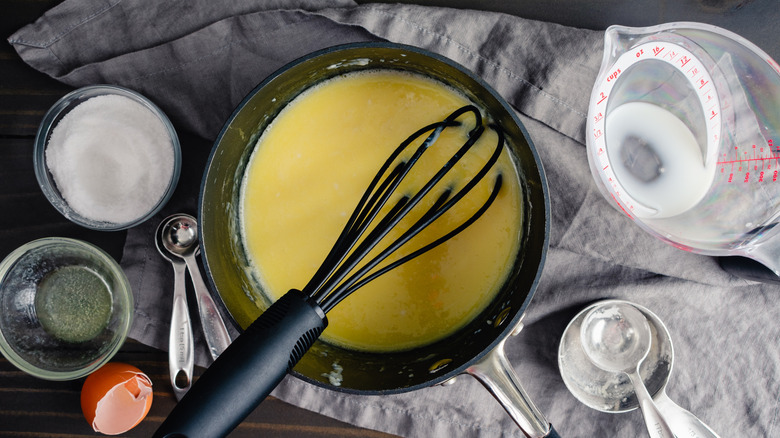Roux Vs Slurry: The Difference, Explained
Whether you're making crawfish étouffée or velveting chicken for stir-fry, thickening agents are key to creating the perfect texture for a multitude of dishes, increasing the viscosity which unites the ingredients and flavors into an incredible, homogenous whole. Incorporating a roux or a slurry are the two most popular methods, but what are these two thickeners, and how can you tell which is the right method to use?
A base in almost all of the five classical mother sauces, the roux originated in France and uses a 1:1 ratio of fat (typically butter) and flour cooked to varying stages — but we'll talk more about that later. As is appropriate, roux is also the backbone of cuisine in Louisiana, thickening everything from seafood gumbo to smothered pork chops. A slurry, on the other hand, is made from root vegetable starches and is the basis of many recipes, particularly in Chinese cuisine.
What is a roux?
An equal mixture of fat and flour, a roux is the first step in countless recipes, from country gravy made with sausage drippings and milk that's served over buttery, homemade biscuits to nutty, Gruyère-rich mornay sauce draped over blanched asparagus spears. Regardless of how it's used, a roux is cooked to eliminate the unappetizing flavor of raw flour before adding additional ingredients. Roux can also lend its own taste to a recipe, as each stage of cooking reveals a more intense flavor.
"First you make a roux" may be a cliché, but it also rings true, as it's often the first step of many Cajun and Creole dishes unique to Louisiana cuisine. Likely one of the most well-known dishes in the state's one-of-a-kind culinary arsenal is gumbo, a thick, hearty stew which requires a dark roux. There's much debate over how many colors a roux can become, but most cooks agree that there are four basic levels: white, blonde, peanut butter, and dark (sometimes called chocolate). White is the most absorbent, capturing the flavorful drippings for fried chicken gravy or a cheesy béchamel; blonde is perfect for a delicate velouté; a nutty peanut butter roux thickens étouffée and enriches heady sauces and soups; and dark or chocolate roux has a toasted, coffee-like flavor and is mostly used for gumbos rich in meat like duck or andouille sausage. One thing to note: As roux gets darker, its thickening properties weaken, so always make sure you're using the right roux for the job.
What is a slurry?
Unlike a roux, a slurry is uncooked and added at the end of a recipe. A slurry is made by combining a starch — such as potato starch, arrowroot powder, flour, or cornstarch — with cold water in a 1:2 ratio. Dissolving the starch in cold water prevents it from clumping when adding it to your dish, but the real magic happens when the slurry hits the heat. This kicks off a process called gelatinization, in which heat causes the starch molecule to expand, thus absorbing more liquid and creating a viscous, translucent texture.
Just consider the thick, glossy consistency of the Cantonese-American dish moo goo gai pan with mushrooms and chicken, or the Vietnamese stir-fry sauce Nước Sốt Xào. Although slurries are often used in cuisines spanning across Asia, they're equally handy in everything from a pork roast gravy made from the drippings to thickening a homemade filling for strawberry rhubarb pie, or even whipping up a creamy batch of classic vanilla pudding.


